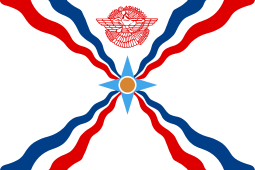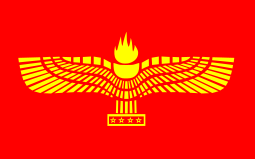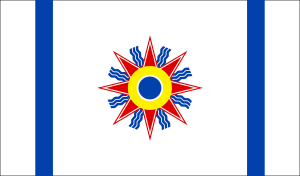Mardin Province
Mardin Province (Turkish: Mardin ili, Kurdish: Parêzgeha Mêrdînê,[2] Classical Syriac: ܡܪܕܐ, Arabic: محافظة ماردين[3]), is a province of Turkey with a population of 809,719 in 2017. The population was 835,173 in 2000. The capital of the Mardin Province is Mardin (Classical Syriac: ܡܶܪܕܺܝܢ "Mardin" Arabic: ماردين, Mardīn). Located near the traditional boundary of Anatolia and Mesopotamia, it has a diverse population, composed of Kurdish, Arab and Assyrian people, with Kurds forming the majority of the province's population.[4]
Mardin Province Mardin ili | |
|---|---|
 Location of Mardin Province in Turkey | |
| Country | Turkey |
| Region | Southeast Anatolia |
| Subregion | Mardin |
| Government | |
| • Electoral district | Mardin |
| • Governor | Mustafa Yaman |
| • Metropolitan Mayor | Ahmet Turk (HDP) |
| Area | |
| • Total | 8,891 km2 (3,433 sq mi) |
| Population (2018)[1] | |
| • Total | 829,195 |
| • Density | 93/km2 (240/sq mi) |
| Area code(s) | 0482 |
| Vehicle registration | 47 |
History
Mardin comes from the Syriac word (ܡܪܕܐ) and means "fortresses".[5][6]
The first known civilization were the Subarian-Hurrians who were then succeeded in 3000 BCE by the Hurrians. The Elamites gained control around 2230 BCE and were followed by the Babylonians, Hittites, Assyrians, Romans and Byzantines.[7]
The local Assyrians/Syriacs, while reduced due to the Assyrian Massacres and conflicts between the Kurds and Turks, hold on to two of the oldest monasteries in the world, Dayro d-Mor Hananyo (Turkish Deyrülzafaran, English Saffron Monastery) and Deyrulumur Monastery. The Christian community is concentrated on the Tur Abdin plateau and in the town of Midyat, with a smaller community (approximately 200) in the provincial capital.
In 1927 the office of the Inspector General was created, which governed with martial law.[8] The province was included in the First Inspectorate-General (Turkish: Birinci Umumi Müfettişlik) over which the Inspector General ruled. The Inspectorate-General span over the provinces of Hakkâri, Siirt, Van, Mardin, Bitlis, Sanlıurfa, Elaziğ and Diyarbakır.[9] The Inspectorate General were dissolved in 1952 during the Government of the Democrat Party.[10] The Mardin province was also included in a wider military zone in 1928, in which the entrance to the zone was forbidden for foreigners until 1965.[11]
In 1987 the province was included in the OHAL region governed in a state of emergency.[12] In November 1996 the state of emergency regulation was removed.[13]
Districts
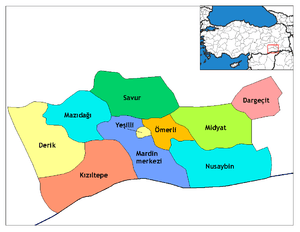
Mardin province is divided into 10 districts (capital district in bold):
Gallery
- Islamic monuments in Mardin Province
 Minaret of the Grand Mosque of Mardin (12th century) and the view of the Mesopotamian plains.
Minaret of the Grand Mosque of Mardin (12th century) and the view of the Mesopotamian plains.- Kasimiye Madrasa (14th century)
 Zinciriye Madrasa (14th century)
Zinciriye Madrasa (14th century)- View of Savur and the grand mosque in the center
- Abdullatif Mosque (14th century)
- Christian monuments in Mardin Province

 Mor Yuhanun Church
Mor Yuhanun Church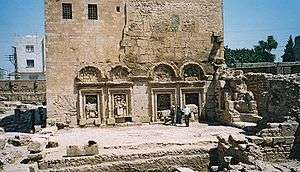 Mar Jacob Church in Nusaybin
Mar Jacob Church in Nusaybin- Dayro d-Mor Hananyo monastery
References
- "Population of provinces by years - 2000-2018". Turkish Statistical Institute. Retrieved 9 March 2019.
- "Karsazekî Kurd ê ji Mêrdînê bi koronayê jiyana xwe ji dest da" (in Kurdish). Rûdaw. 3 April 2020. Retrieved 27 April 2020.
- المستدرك على تتمة الأعلام. "المستدرك على تتمة الأعلام" (in Arabic). p. 138.
- Watts, Nicole F. (2010). Activists in Office: Kurdish Politics and Protest in Turkey (Studies in Modernity and National Identity). Seattle: University of Washington Press. p. 167. ISBN 978-0-295-99050-7.
- Lipiński, Edward (2000). The Aramaeans: Their Ancient History, Culture, Religion. Peeters Publishers. p. 146. ISBN 978-90-429-0859-8.
- Payne Smith's A Compendious Syriac Dictionary, Dukhrana.com
- "- Antik Tatlıdede Konağı - Mardin". www.tatlidede.com.tr. Retrieved 19 March 2018.
- Jongerden, Joost (2007-01-01). The Settlement Issue in Turkey and the Kurds: An Analysis of Spatical Policies, Modernity and War. BRILL. p. 53. ISBN 978-90-04-15557-2.CS1 maint: date and year (link)
- Bayir, Derya (2016-04-22). Minorities and Nationalism in Turkish Law. Routledge. p. 139. ISBN 978-1-317-09579-8.
- Fleet, Kate; Kunt, I. Metin; Kasaba, Reşat; Faroqhi, Suraiya (2008-04-17). The Cambridge History of Turkey. Cambridge University Press. p. 343. ISBN 978-0-521-62096-3.
- Jongerden, Joost (2007-05-28). The Settlement Issue in Turkey and the Kurds: An Analysis of Spatial Policies, Modernity and War. BRILL. p. 303. ISBN 978-90-474-2011-8.
- Biner, Zerrin Ozlem (2019-11-08). States of Dispossession: Violence and Precarious Coexistence in Southeast Turkey. University of Pennsylvania Press. ISBN 978-0-8122-9659-4.
- "Turkey, Country Assessment, November 2002" (PDF). Ecoi. Retrieved 8 April 2020.
External links
| Wikimedia Commons has media related to Mardin Province. |
